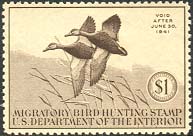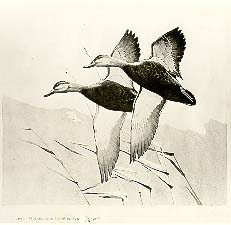

Back to RW7 Back to the Federal Index Home
A LITTLE HISTORY ON THE 7TH (1940-41) DUCK STAMP ARTIST


If all of Francis Lee Jaques' background paintings were put together, they would total close to 30,000 square feet. Consider this with the fact that he did not begin work as an artist until he was 33 years old, and the quantity becomes even more astounding.
Francis Lee Jaques was the son of Ephraim Parker and Emma Jane (Monninger) Jaques and was born in Geneseo, Illinois on September 28, 1887. When he was about nine years old, the family moved to Kansas. About ten years later, his family decided to move to northern Minnesota. The Jaques traveled with a horse drawn wagon on a long trek of nearly 600 miles over primitive roads. Mr. Jaques and his father walked most of the way.
His early travel experiences proved valuable when he was hired by the American Museum of Natural history in New York city in 1924.
Using the wealth of material he gained in his travels, Mr. Jacques produced a multitude of background paintings that can still be seen in many American museums. The enduring testimony to the ability of Mr. Jacques can be admired by millions in the American Museum of Natural History in New York City, Museum of Science in Boston, Peabody Museum in New Haven, Academy of Natural Sciences of Philadelphia, Minnesota Museum of Natural History, University of Nebraska Museum, and similar exhibits in Texas.
Mr. Jaques found a companion for his travels in Florence Sarah Page, a talented writer. The two were married on May 12, 1927. Beginning in 1938, they collaborated on the production of seven outstanding books: As Far as the Yukon, Canadian Spring, Snowshoe Country, Canoe Country, The Geese Fly High, Birds Across the Sky, and There Once Was a Puffin.
In addition to the collaborations with his wife, Mr. Jaques also illustrated several other books. They are: Oceanic Birds of South America, South Carolina Bird Life, Florida Bird Life, and Outdoor Life's Gallery of North American Game.
Mr. Jaques left the American Museum of Natural History in 1942, but continued to do free-lance work for some time. In addition to his background paintings, he did many easel paintings in oil His illustrations appeared in Life, Saturday Evening Post, Outdoor Life, Field and Stream, and other national magazines. After 47 years of painting wildlife subjects, he was regarded as a world famous figure.
Mr. Jaques was a member of the Explores Club and belonged to the American Ornithologists Union. He and his wife were the recipients of the John Burroughs Medal, an annual national award for the best nature study book.
Mr. Jaques passed away in July 1969.
---------------THE ART---------------
Black Ducks was painted in ink wash on watercolor paper. A stone lithograph was prepared. The prints were on Curtis litho paper, hand pulled and printed in black ink. All prints were signed in pencil and not numbered. The print image size is 7 1/4"x10".
---------------THE STAMP---------------
Black ducks...Engraved by the Federal Bureau of Engraving from the original artwork. Printed in sepia ink. The stamp sold for one dollar. Postal records show 1,260,810 stamps sold. First day of sale was July 1, 1940.
Most of the information contained above is from the book Federal Duck Stamp Story, Fifty Years of Excellence, by Laurence F. Jonson; Alexander & Co. It is used here with permission from the author. For more information on this book, please click here.